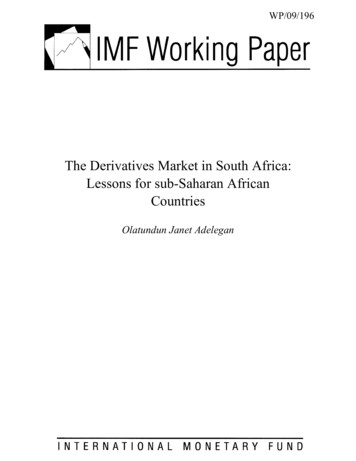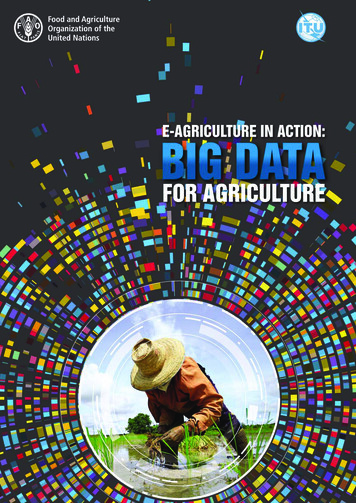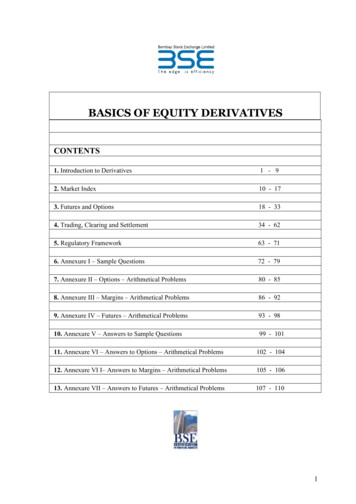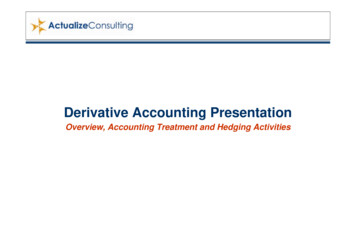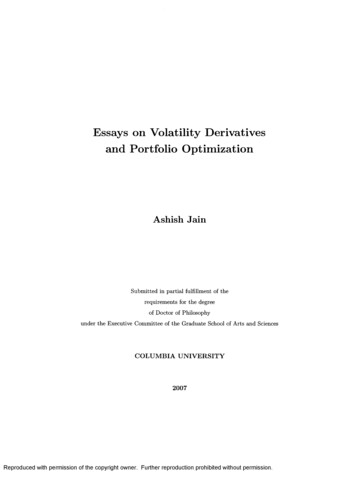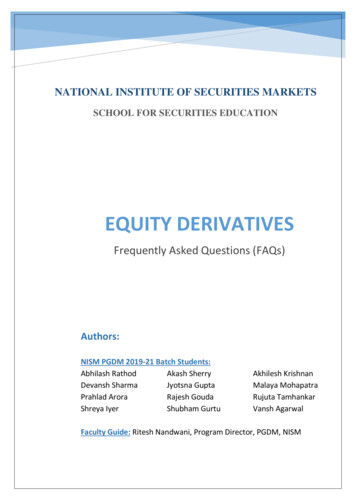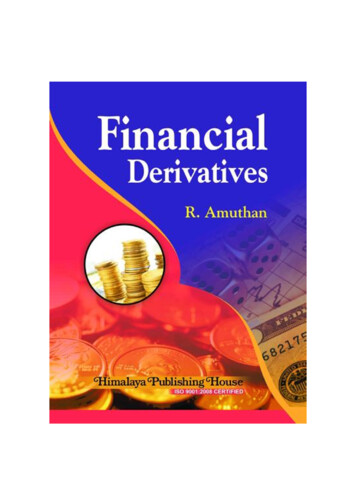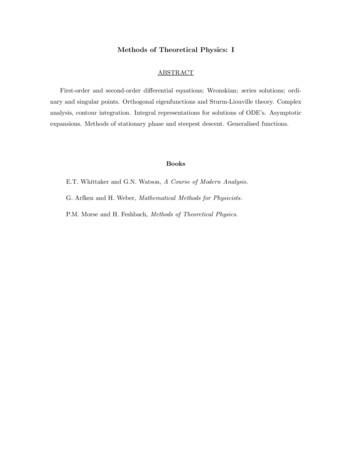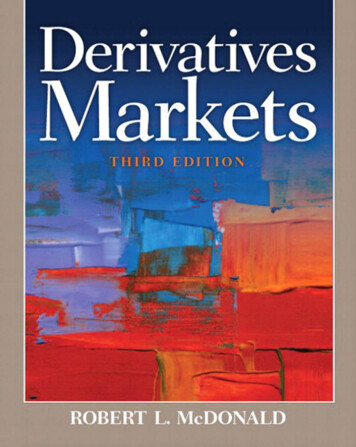
Transcription
Derivatives & AgricultureLecture NotesSheri LiuG Cornelis van Kooten
OutlineIntroductionFutures and ForwardsOptionsWeather derivatives
Markets for Trading DerivativesExchange-traded market:Individuals trade standardized contracts that havebeen defined by the exchange (e.g., ChicagoMercantile Exchange, International ContinentalExchange or ICE in Winnipeg)Over-the-counter (OTC) market:Individualized contracts where the market consists ofa telephone-and computer-linked network of dealersRefences: Colin A. Carter, 2003. Futures and Options Markets. (Prentice Hall).John C. Hull, 2012. Options, Futures, and Other Derivatives. 8th ed. (Pearson Education).
Types of TradersHedgers use financial derivatives (such as options) to reduce therisk that they face from potential future movements in a marketvariable (crop prices, stock values) or even physical variable(weather).Speculators use financial derivatives to bet on the futuredirection of a market or other variableArbitrageurs take offsetting positions in two or more financialinstruments to lock in a profit.
Main Types of Derivative InstrumentsDifferences:Common features:a contractbetween twoparties for tradingsomething in thefuture with theterms and priceagreed upontoday; marginrequirements (notfor optionsbuyers).Futures: contracts are standardized,traded through futures exchanges,subject to daily settlement,guaranteed by a clearinghouse, andhas marketability.Forwards: contracts are nonstandardized, traded OTC, and usuallysettled on the pre-determined date.Options: buyer of an option has rightbut no obligation while seller has theobligation to deliver when the option isexercisedSwaps: usually involves a series of cashflows at a few dates; fixed-floating
Main Types of Derivatives’ Underlying ts/#pageNumber 1&sortAsc false&sortField oi
Futures & ForwardsBenefits of futures tradingHedge risk: Futures trading enables producers to hedge therisks of planting a crop, say, by ensuring the price at harvesttimeEnhance price discovery: A commodity firm making a largesale to an overseas buyer can immediately turn around andhedge the sale on a futures market; this transfersinformation from those who have it to those who do notPromote storage and enhance efficiency: Prior to futurestrading, there were wide swings in agricultural prices;futures trading made storage profitable.
Futures contracts started withgrains and agricultural productsand gradually expanded tonatural resources (e.g., metalsand energy products) andfinancial futures. Trading volumes and number ofmarkets have increased rapidlysince trading-statisticsshowing-record-etd-volume-2018
Futures Contracts for Agriculture– Grains and Oilseeds (wheat, corn, soybeans, palm oil, rice, etc.)– Livestock and meat (cattle, hogs)– Dairy (milk, butter, cheese)– Food and fiber (cocoa, coffee, l/#featured
Corn Futures l/grain-and-oilseed/corn quotes globex.html
Two Parties of A Futures ContractSimilar to a spot contract,which is an agreement tobuy or sell an asset today,there are two parties tothe contract: One party assumes a long position, agreeing tobuy the underlying asset on a certain specifiedfuture date for a certain specified price Other party assumes a short position, agreeing tosell the asset on the same date for the same priceLong position: holder ofthe contract is obligatedto buy the asset specifiedin the contract Pay-off ST – K, where ST is spot price of asset atmaturity T and K is the ‘delivery price’ or whatthe holder of the long contract has to pay for theassetShort position: holder ofcontract is obligated tosell the asset specified inthe contract Pay-off K – ST if future spot price the pricereceived by counter-party, the holder loses;otherwise, the holder gains.
A Simple Example for PayoffsLong position payoff with K 100 at maturitySource: Sacks 2015, p.11-12Short position payoff with K 100 at maturityReference: Sacks, J. (2015). Elementary financial derivatives : a guide to trading andvaluation with applications. Wiley.
Offset & SettlementBecause of the commission costs and the costs of storingand/or transporting commodities, the majority of thefutures traders choose to offset their positions by takingan opposite position before the maturity of the contract,instead of taking delivery.If a futures trader keeps the position open after theexpiration date, the settlement can be either in physicalform or in cash. Most of futures contracts are settledwith a payment, instead of taking possession of theunderlying asset.Johnson, R.S. (2017). Derivatives markets and analysis. John Wiley & Sons, Inc., Hoboken, New Jersey.
One Key Component for Facilitating FuturesTrading -- Clearinghouse (CH)A corporation that is separate from but associatedwith a futures exchangeAll futures trades are cleared through the CH at theend of the dayTrades must be cleared through a member of the CH,with member paid a commission fee for this serviceCH balances books on outstanding futures accounts atthe end of each trading dayCH facilitates delivery on futures contracts
Illustration of Operation of Clearinghouse(Carter 2003, p.70; Johnson 2017, alueCH positionOpenlongsOpenshorts1AB 19,450A’s seller, B’s buyerAB2CA 20,700C’s seller, A’s buyerCB3BC 18,150B’s seller, C’s buyerCH facilities delivery: in essence, the CH becomes each buyer’s seller and each seller’s buyer.Suppose A takes a long position on a July corn futures worth 19,450 (committed to buy5000 bushels of corn for 3.89/bu at the settlement date in July), while B takes a shortposition of the same transaction. It is the CH, however, which has committed to acceptdelivery from B and to deliver to A.Suppose the next day, A sells a July corn futures contract to C at 4.14/bu. Now A’s position isclosed and the CH pays A (through a broker) a total of 1,250 ( (4.14-3.89)*5,000).Meanwhile, because the market moved ‘against’ B and B’s commitment is ‘marked tomarket’, at the end of day 2, B receives a ‘margin call’ and will be required to input 1,000into his account (assuming initial and maintenance margins are same).If C and B liquidate their positions at 3.63/bu on day 3, how much does C lose and what isB’s profit?
OptionsBackground – a few key featuresTraded on exchange and OTC marketsAn option gives the buyer the right to do somethingBuyer does not have to exercise this right, unlike in a forward or futurescontract, where seller (writer) is obligated to buy or sell the underlyingasset if the option is exercises.There is a cost (premium) to acquiring an option, unlike with a forward orfutures contract
Background – some conceptsCall (Put) option: gives holder of an options contract the right to buy (sell) theunderlying asset by a certain date for a certain priceStrike Price: the exercise price of the contractExpiration Date: time at which the option is due, or maturity dateFor call/put options, buyers are referred to as having long positions; sellers arereferred to as having short positionsAmerican option contracts can be exercised any time up to the expiration dateEuropean option contracts can only be exercised on the expiration date
Background – related to option tradingCall option contracts on 16 stocks started to trade in 1973 on theChicago Board Options Exchange (CBOE)Put option contracts started trading on CBOE in 1977.For over-the-counter (OTC) options, financial institutions often act asmarket makers (defined below) for the more commonly tradedinstrumentsDisadvantage of OTC trades is potential credit risk – that the contract isnot honoredExchanges have organised themselves to eliminate virtually all credit riskbut not basis risk -- the value of a derivatives contract does not move inline with that of the underlying exposure
Background – Market Makers (1)Exchanges use market makers tofacilitate trading. Market maker quotesboth a bid and an offer price on aninstrument.In general, bidis a price atwhich atrader isprepared tobuySimilarly, offer(ask) is a priceat which atrader isprepared tosellOffer alwaysexceeds thebid with thedifferencereferred to asthe bid-offerspreadExchange sets upperlimits for the bid-offerspread. For example,exchange specifiesthat spread notexceed 0.25 foroptions priced at lessthan 5; 0.50 forthose priced between 5 and 10; 0.75 forthose priced between 10 and 20; and 1for options pricedover 20)Marketmakers maketheir profitsfrom the bidoffer spread.
Background– Market Makers -making/
Background – Market Makers (3)Source: kers
An Example of An Option ral/grain-and-oilseed/kc-wheat contractSpecs options.html?optionProductId 349&optionExpiration 349-J9#optionProductId 349
Two Parties of An Options ContractSame as a futures contract,there are two parties to thecontract: Investor who takes a long position (i.e., agreedto buy option) Investor who takes a short position (i.e., hassold or written the option)Long position: holder ofthe contract has right (noobligation) to buy (longcall) or sell (long put) theasset specified in thecontract Long call: Payoff max(ST – K, 0), as the optionis only exercised if ST K, where ST is spot priceof asset at maturity T and K is the strike price Long short: Payoff max(K – ST, 0)Short position: holder ofcontract is obligated to buy(short put) and sell (shortcall) the asset specified inthe contract Short call: Payoff max(K – ST, 0) Short put: Payoff max(ST – K, 0)
A Figure for Showing Payoffs with Premium
QuestionsQ1Suppose wepurchased a 3.65July KC wheat putoption for 18cents a bushel viaCME. What is theunderlyinginstrument, strikeprice, premium?Q2To protect againstfalling prices,should we buy acall or a putoption?
Illustration of Wheat Futures Options: May 17, 2002 WSJ (Carter 2003)Wheat (CBT)5,000 bu.; cents per 7.2505.250Calls ts4.0007.00011.12516.12522.37529.375Buyer of an options contract in wheat can choose strike prices ranging from 2.60/bu to 3.10/bu. Suppose he chooses to go long on a July wheat options contract at a strikeprice of 2.80/bu. The premium for this option is 0.0675/bu 5,000 bu 337.50,which is paid immediately. If wheat July futures price falls below 2.80/bu, he choosesnot to exercise the option, lets the option expire and loses 337.50. If July price exceeds 2.80/bu, he exercises the option and acquires a long position in the futures market. IfJuly price exceeds 2.8675/bu, he will exercise and earn positive net profit. Of course,he can choose to sell a call on a July wheat options contract to offset his position.
Option PricesMain factors that affectingtime value:Comprised oftwo parts:Intrinsic value: Intrinsicvalue Time value In the money At the money Out of the money Time to expiration, T Volatility of the underlyinginstrument, σ Risk-free interest rate, r Intrinsic value Dividends that areexpected to be paid ifapplicable
QuestionsIf CME May corn futures are tradingat 4.25 and the 4.00 May corn calloption is priced at 50 cents perbushel, what is the premium,intrinsic value and time value?Q3Q4Suppose you sold a CME 4.50 Julycorn call and CME July corn futuresfell to 4.25 on the expiration date, isit possible that you will be required tofulfill the obligation to sell a July cornfutures contract?
More QuestionsQ5Q6If you sell a CMESeptember 3.90 wheatcall option at 0.6, whatis your maximum net lossper bushel in theory?If what you sell is a putoption at 0.4, what isyour maximum net lossper bushel in theory?Suppose a producer purchases aNovember soybean put option with astrike price of 4.5 for a premium of 0.5.In October, the price of soybean dropsto 4.0 and the premium rises to 0.8.The producer offsets his optionposition and sells his soybeansimultaneously (assuming no basisrisk and costs). What is her net price?
Weather Derivatives Derivatives are designed based on outcomes of weather indexes,which are not traded in other markets. The prime objective is to hedge against volume risk, rather thanprice risk.Müller, A., & Grandi, M. (2000). Weather Derivatives: A Risk Management Tool for Weather SensitiveIndustries. The Geneva Papers on Risk and Insurance. Vol 25. No. 2, 273- 287.
Types of Weather IndexesTemperature is the main underlying weather factor forderivatives. Number of days/hours that temperature in certain weeks in late Fall isbetween –5oC and –8oC for grapes used in making ice wine Heating degree days (HDDs): number of days when temperatures arebelow 65oF and space heating services are required Cooling degree days (CDDs): number of days when temperatures are above65oF and space cooling services are required Growing degree days (GDDs): during growing season, the number of daysthat temperatures are above 5oC and there is enough heat for crop growth Cumulative average temperature (CAT): the cumulative amount oftemperature over a period, which can be seasonal or monthly.Rainfall, early frosts, hail, snowfall et cetera, can all be usedas weather indexes.
Formulas and An Example𝐻𝐷𝐷𝑀𝑎𝑥 65𝑇 ,0𝐶𝐷𝐷𝑀𝑎𝑥 𝑇65, 0𝐺𝐷𝐷𝑀𝑎𝑥 𝑇5, 0𝐶𝐴𝑇𝑇𝑇Note: 18 oC is used as thebenchmark in EUSource: res‐introduction‐to‐weather‐derivatives/
PayoffsA call option can be claimed when the value of the weatherindex is above a specified strike value, while a put option canbe claimed when the value of the weather index is below aspecified valuep ( w) put ( K1 w), if w K1 if w K1 0 ,p ( w) callif w K 2 0 , ( w K 2 ), if w K 2where p(w) is the payoff; λ is the tick size (dollar value perunit of the weather index); K1 and K2 are the strike values,respectively; and w is the weather index.
Where to Buy Weather DerivativesCMEStandard contracts andeasy to writeOTCWritten on index measuredlocally, even at farm levelCarry basis risk Precipitation varies toomuch, even across locallandscape Temperatures measuredin Calgary not helpful forfarm in ReginaFlexiblePotential high credit risk
The Beginning of Weather Derivatives1997: First weather transactions(OTC) took place between Enronand Koch Industries, based uponsome temperature indices tocompensate the energyproducer in case of a mild winter1999: Trading inweather derivativesbegan on the ChicagoMercantile Exchange(CME), with HDDs1998: First Europeandeals took placebetween Enron andScottish Hydro Electricon a similar basis
Some Key Dates on CMEHowever, many derivative products could not draw enough tradersand were unlisted. Now CME offers HDD and CDD contracts for 8American cities (Las Vegas, Atlanta, Chicago, Cincinnati, New York,Dallas, Minneapolis, Sacramento); HDD and CAT contracts for 2European cities (London, Amsterdam).
QuestionsHDD call options can beused to protect againstthe negative impactsfrom cold or warmwinter on business.Beverage or ice-creamindustry can use CDD callor put options to hedgethe risk of cool l
Pricing Weather DerivativesThe premium (price of option) is calculated from the expectedpayoff:c e–r(T – t) Epwhere c is the premium, r is a risk-free periodic market interest rate,t is the date the contract is issued, T is the date the contract isclaimed, and Ep is the expected payoff: Ep p(w) f(w) dw0where f(w) is the probability density function of the weatherindex w, p(w) is the payoff, and the integral is from 0 to because w cannot take on negative values.
Modelling Weather Variables Two methods Time series(econometrics) Stochastic processes(simulation)DailyTemperatures Two aspects Frequency(2 state Markov chain ) Magnitude(distribution)DailyPrecipitation
If a futures trader keeps the position open after the expiration date, the settlement can be either in physical form or in cash. Most of futures contracts are settled with a payment, instead of taking possession of the underlying asset. Johnson, R.S. (2017). Derivatives markets and analysis. John Wiley & Sons, Inc., Hoboken, New Jersey.
